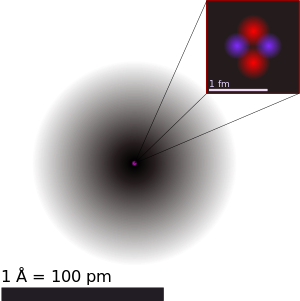
The atomic nucleus is the small, dense region consisting of protons and neutrons at the center of an atom, discovered in 1911 by Ernest Rutherford based on the 1909 Geiger–Marsden gold foil experiment. After the discovery of the neutron in 1932, models for a nucleus composed of protons and neutrons were quickly developed by Dmitri Ivanenko[1] and Werner Heisenberg.[2][3][4][5][6] An atom is composed of a positively charged nucleus, with a cloud of negatively charged electrons surrounding it, bound together by electrostatic force. Almost all of the mass of an atom is located in the nucleus, with a very small contribution from the electron cloud. Protons and neutrons are bound together to form a nucleus by the nuclear force.
The diameter of the nucleus is in the range of 1.70 fm (1.70×10−15 m[7]) for hydrogen (the diameter of a single proton) to about 11.7 fm for uranium.[8] These dimensions are much smaller than the diameter of the atom itself (nucleus + electron cloud), by a factor of about 26,634 (uranium atomic radius is about 156 pm (156×10−12 m))[9] to about 60,250 (hydrogen atomic radius is about 52.92 pm).[a]
The branch of physics concerned with the study and understanding of the atomic nucleus, including its composition and the forces that bind it together, is called nuclear physics.
The nucleus was discovered in 1911, as a result of Ernest Rutherford's efforts to test Thomson's "plum pudding model" of the atom.[10] The electron had already been discovered by J. J. Thomson. Knowing that atoms are electrically neutral, J. J. Thomson postulated that there must be a positive charge as well. In his plum pudding model, Thomson suggested that an atom consisted of negative electrons randomly scattered within a sphere of positive charge. Ernest Rutherford later devised an experiment with his research partner Hans Geiger and with help of Ernest Marsden, that involved the deflection of alpha particles (helium nuclei) directed at a thin sheet of metal foil. He reasoned that if J. J. Thomson's model were correct, the positively charged alpha particles would easily pass through the foil with very little deviation in their paths, as the foil should act as electrically neutral if the negative and positive charges are so intimately mixed as to make it appear neutral. To his surprise, many of the particles were deflected at very large angles. Because the mass of an alpha particle is about 8000 times that of an electron, it became apparent that a very strong force must be present if it could deflect the massive and fast moving alpha particles. He realized that the plum pudding model could not be accurate and that the deflections of the alpha particles could only be explained if the positive and negative charges were separated from each other and that the mass of the atom was a concentrated point of positive charge. This justified the idea of a nuclear atom with a dense center of positive charge and mass.
The term nucleus is from the Latin word nucleus, a diminutive of nux ('nut'), meaning 'the kernel' (i.e., the 'small nut') inside a watery type of fruit (like a peach). In 1844, Michael Faraday used the term to refer to the "central point of an atom". The modern atomic meaning was proposed by Ernest Rutherford in 1912.[11] The adoption of the term "nucleus" to atomic theory, however, was not immediate. In 1916, for example, Gilbert N. Lewis stated, in his famous article The Atom and the Molecule, that "the atom is composed of the kernel and an outer atom or shell."[12]Similarly, the term kern meaning kernel is used for nucleus in German and Dutch.

The nucleus of an atom consists of neutrons and protons, which in turn are the manifestation of more elementary particles, called quarks, that are held in association by the nuclear strong force in certain stable combinations of hadrons, called baryons. The nuclear strong force extends far enough from each baryon so as to bind the neutrons and protons together against the repulsive electrical force between the positively charged protons. The nuclear strong force has a very short range, and essentially drops to zero just beyond the edge of the nucleus. The collective action of the positively charged nucleus is to hold the electrically negative charged electrons in their orbits about the nucleus. The collection of negatively charged electrons orbiting the nucleus display an affinity for certain configurations and numbers of electrons that make their orbits stable. Which chemical element an atom represents is determined by the number of protons in the nucleus; the neutral atom will have an equal number of electrons orbiting that nucleus. Individual chemical elements can create more stable electron configurations by combining to share their electrons. It is that sharing of electrons to create stable electronic orbits about the nuclei that appears to us as the chemistry of our macro world.
Protons define the entire charge of a nucleus, and hence its chemical identity. Neutrons are electrically neutral, but contribute to the mass of a nucleus to nearly the same extent as the protons. Neutr